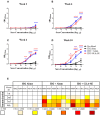Induction of Fc-Mediated Effector Functions Against a Stabilized Inner Domain of HIV-1 gp120 Designed to Selectively Harbor the A32 Epitope Region
- PMID: 31001276
- PMCID: PMC6455405
- DOI: 10.3389/fimmu.2019.00677
Induction of Fc-Mediated Effector Functions Against a Stabilized Inner Domain of HIV-1 gp120 Designed to Selectively Harbor the A32 Epitope Region
Abstract
Recent clinical trials and studies using nonhuman primates (NHPs) suggest that antibody-mediated protection against HIV-1 will require α-HIV envelope humoral immunity beyond direct neutralization to include Fc-receptor (FcR) mediated effector functions such as antibody-dependent cellular cytotoxicity (ADCC). There is also strong evidence indicating that the most potent ADCC response in humans is directed toward transitional non-neutralizing epitopes associated with the gp41-interactive face of gp120, particularly those within the first and second constant (C1-C2) region (A32-like epitopes). These epitopes were shown to be major targets of ADCC responses during natural infection and have been implicated in vaccine-induced protective immunity. Here we describe the immunogenicity of ID2, an immunogen consisting of the inner domain of the clade A/E 93TH057 HIV-1 gp120 expressed independently of the outer domain (OD) and stabilized in the CD4-bound conformation to harbor conformational A32 region epitopes within a minimal structural unit of HIV-1 Env. ID2 induced A32-specific antibody responses in BALB/c mice when injected alone or in the presence of the adjuvants Alum or GLA-SE. Low α-ID2 titers were detected in mice immunized with ID2 alone whereas robust responses were observed with ID2 plus adjuvant, with the greatest ID2 and A32-specific titers observed in the GLA-SE group. Only sera from groups immunized in the presence of GLA-SE were capable of mediating significant ADCC using NKr cells sensitized with recombinant BaL gp120 as targets and human PBMCs as effectors. A neutralization response to a tier 2 virus was not observed. Altogether, our studies demonstrate that ID2 is highly immunogenic and elicits A32-specific ADCC responses in an animal host. The ID2 immunogen has significant translational value as it can be used in challenge studies to evaluate the role of non-neutralizing antibodies directed at the A32 subregion in HIV-1 protection.
Keywords: A32 epitope; ADCC (Antibody dependent cellular cytotoxicity); Fc-mediated effector function; HIV envelope; ID (Inner domain) immunogen.
Figures






Similar articles
-
Cocrystal Structures of Antibody N60-i3 and Antibody JR4 in Complex with gp120 Define More Cluster A Epitopes Involved in Effective Antibody-Dependent Effector Function against HIV-1.J Virol. 2015 Sep;89(17):8840-54. doi: 10.1128/JVI.01232-15. Epub 2015 Jun 17. J Virol. 2015. PMID: 26085162 Free PMC article.
-
Structural definition of an antibody-dependent cellular cytotoxicity response implicated in reduced risk for HIV-1 infection.J Virol. 2014 Nov;88(21):12895-906. doi: 10.1128/JVI.02194-14. Epub 2014 Aug 27. J Virol. 2014. PMID: 25165110 Free PMC article.
-
Paring Down HIV Env: Design and Crystal Structure of a Stabilized Inner Domain of HIV-1 gp120 Displaying a Major ADCC Target of the A32 Region.Structure. 2016 May 3;24(5):697-709. doi: 10.1016/j.str.2016.03.005. Epub 2016 Mar 31. Structure. 2016. PMID: 27041594 Free PMC article.
-
Structural Basis for Epitopes in the gp120 Cluster A Region that Invokes Potent Effector Cell Activity.Viruses. 2019 Jan 16;11(1):69. doi: 10.3390/v11010069. Viruses. 2019. PMID: 30654465 Free PMC article. Review.
-
Conformational Masking and Receptor-Dependent Unmasking of Highly Conserved Env Epitopes Recognized by Non-Neutralizing Antibodies That Mediate Potent ADCC against HIV-1.Viruses. 2015 Sep 18;7(9):5115-32. doi: 10.3390/v7092856. Viruses. 2015. PMID: 26393642 Free PMC article. Review.
Cited by
-
Incorporating the Cluster A and V1V2 Targets into a Minimal Structural Unit of the HIV-1 Envelope to Elicit a Cross-Clade Response with Potent Fc-Effector Functions.Vaccines (Basel). 2021 Aug 31;9(9):975. doi: 10.3390/vaccines9090975. Vaccines (Basel). 2021. PMID: 34579212 Free PMC article.
-
Three families of CD4-induced antibodies are associated with the capacity of plasma from people living with HIV to mediate ADCC in the presence of CD4-mimetics.J Virol. 2024 Oct 22;98(10):e0096024. doi: 10.1128/jvi.00960-24. Epub 2024 Sep 4. J Virol. 2024. PMID: 39230306 Free PMC article.
-
Safety, pharmacokinetics, and biological activity of CD4-mimetic BNM-III-170 in SHIV-infected rhesus macaques.J Virol. 2025 May 20;99(5):e0006225. doi: 10.1128/jvi.00062-25. Epub 2025 Apr 7. J Virol. 2025. PMID: 40192306 Free PMC article.
-
Recognition Patterns of the C1/C2 Epitopes Involved in Fc-Mediated Response in HIV-1 Natural Infection and the RV114 Vaccine Trial.mBio. 2020 Jun 30;11(3):e00208-20. doi: 10.1128/mBio.00208-20. mBio. 2020. PMID: 32605979 Free PMC article.
-
HIV-1 Vpu restricts Fc-mediated effector functions in vivo.Cell Rep. 2022 Nov 8;41(6):111624. doi: 10.1016/j.celrep.2022.111624. Cell Rep. 2022. PMID: 36351384 Free PMC article.
References
Publication types
MeSH terms
Substances
Grants and funding
LinkOut - more resources
Full Text Sources
Research Materials
Miscellaneous

